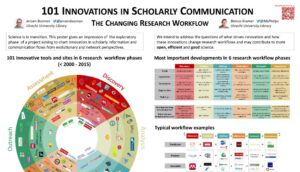The availability and use of digital tools supporting the research workflow—tools for discovery, analysis, writing, publication, outreach and assessment—has exploded in recent years. Several major companies involved in publishing, distribution, and discovery have entered the “research services” space, along with numerous start-ups, large and small.
Here at George Mason University, for example, tools such as Zotero, Omeka, and PressForward have been developed by the Roy Rosenzweig Center for History and New Media to help researchers organize, cite, curate, and publish research and collections.
Bianca Kramer and Jeroen Bosman, researchers at Utrecht University Library, are conducting a global survey on the use of digital tools in the research workflow. Kramer and Bosman have developed the “101 Innovations in Scholarly Communications” website, blog, database, examples of workflows, presentations, and posters supporting this project. Kramer and Bosman provide an excellent launching pad to explore the changes underway in research and scholarly communication; their database now includes more than 575 tools.
There are some advantages to participating in the survey:
- You’ll be able to benchmark yourself against your peers—after completing the survey you can opt in to be provided with a visualization of your use of digital tools compared to your peers.
- Institutions/universities can receive a customized URL that will allow them to see digital research tool usage within their institution/university.
- You’ll contribute to the international effort to chart the evolving landscape of scholarly communication.
Anyone carrying out research (from Master’s students to professors), or supporting research (such as librarians, publishers and funders) can participate.
Faculty and students from George Mason University should take the survey from our custom survey ULR, which will allow Mason Publishing and the University Libraries to compare (anonymous) data from Mason peers.
The survey will run until February 2016.
It takes about 10 minutes to complete and you can opt to receive a visual characterization of your workflow compared to that of your peer group via email.
Kramer and Bosman’s report on the survey’s preliminary results indicate that through October 31, 2015, the survey has generated more than 5,373 responses, primarily from faculty and PhD students. Disciplines are fairly well distributed although Life Sciences has taken the lead with 1,903 responses. Kramer and Bosman also reported on the differences, to date, between librarians and researchers (Faculty/PhD students/Postdocs) regarding the use of tools to measure impact, such as Altmetric, Impactstory, Scopus, JCR, and others. Researchers are using traditional impact factor tools while librarians are using or recommending altmetric tools at a higher rate than their researcher counterparts.
For more information on this survey and its results so far: https://101innovations.wordpress.com
From free, open source tools like Zotero, to Thomson Reuters’ EndNote, from Hypothes.is to Google’s Ngram Viewer, the availability of new digital tools is changing the way students, faculty, and other researchers are creating, sharing, and processing information. This revolution is not being televised.
University Press Week:
This post is part of the #UPWeek blog tour.
Visit the other University Press blog posts on today’s topic, The Future of Scholarly Publishing:

